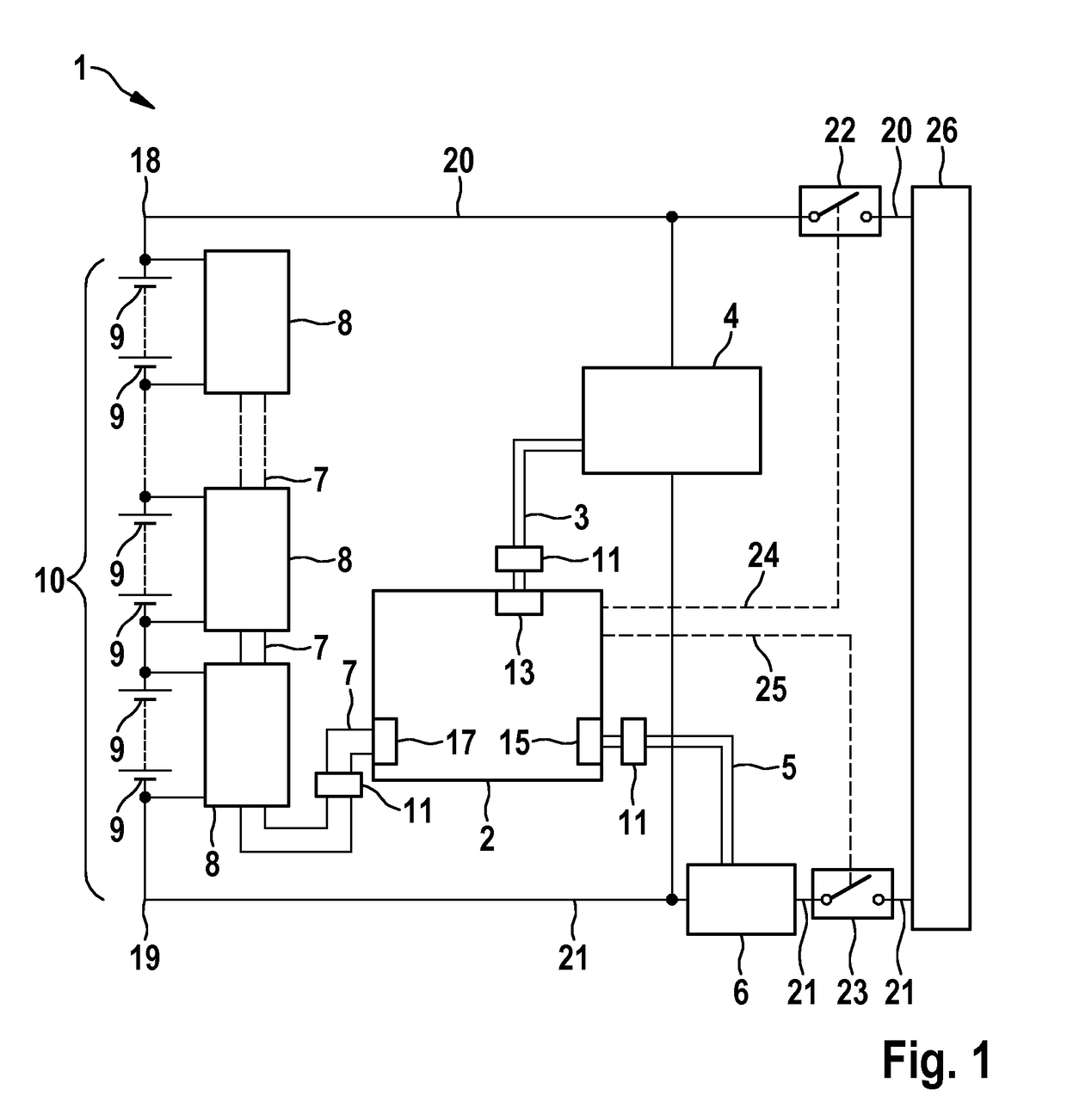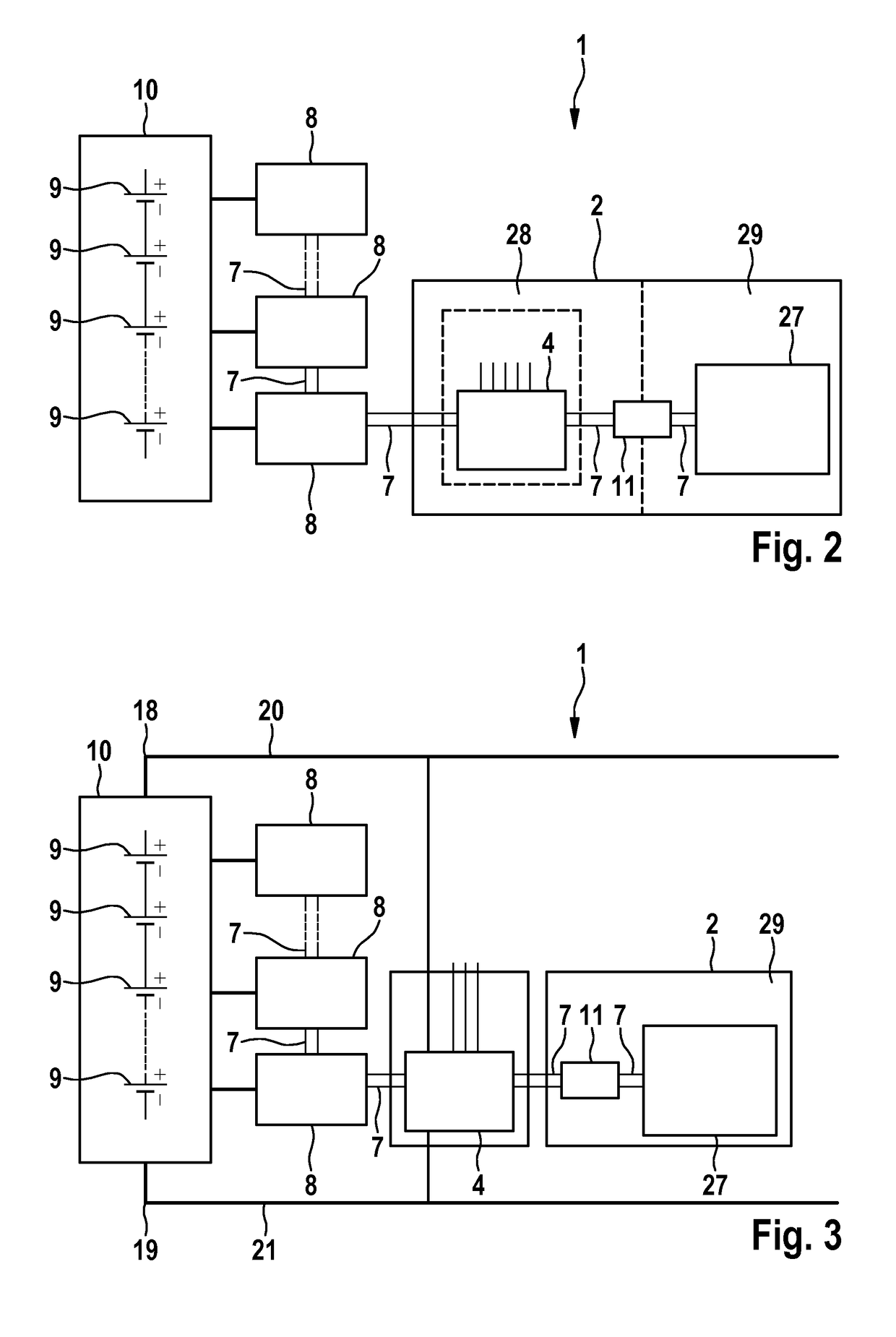Battery management system for a battery having a plurality of battery cells, and method therefor
a battery and management system technology, applied in battery/fuel cell control arrangement, secondary cell servicing/maintenance, instruments, etc., can solve the problems of high voltage measurement, high voltage value and current value (if required), and scanning as simultaneously as possible, so as to reduce the wiring requirement, and the effect of high voltag
- Summary
- Abstract
- Description
- Claims
- Application Information
AI Technical Summary
Benefits of technology
Problems solved by technology
Method used
Image
Examples
first embodiment
[0039]FIG. 2 shows schematically the configuration of a battery management system according to the invention in a This embodiment is similar in some respects to the battery management system 1 according to the prior art, which was described in relation to FIG. 1. Identical components and features are denoted with the same reference numerals and are only described separately with regard to differences. It is important to mention the embodiments with regard to FIG. 1. The main difference to the prior art is the elimination of the bus systems 3 and 5. In order that the high-voltage measuring device 4 can communicate with devices which further process the data thereof, the high-voltage measuring device 4 is integrated into the bus 7 to the low-voltage measuring devices 8. The high-voltage measuring device is integrated into the battery control unit 2 in this embodiment so that said control unit has a high-voltage section 28 and a low-voltage section 29. The connection lines of the high...
second embodiment
[0040]FIG. 3 shows schematically the battery management system 1 according to the invention, which coincides to a large extent to the embodiment depicted in FIG. 2. The following discussion will only deal with differences to this embodiment. Identical features and components are denoted with the same reference numerals. In contrast to the embodiment depicted in FIG. 2, the high-voltage measuring device 4 is separated from the battery control unit 2 and configured as a separate unit. This facilitates a greater degree of flexibility in distributing the components, e.g. in an electric vehicle, where cable length can be spared in the wiring layout. In FIG. 3, the poles of the battery 18 and 19 and the connection paths 20 and 21 connected thereto are depicted. The high-voltage measuring device 4 is connected to these connection paths 20 and 21; thus enabling said device to measure the voltage between the potentials thereof.
third embodiment
[0041]FIG. 4 shows schematically the battery management system 1 which coincides in substantial parts to the embodiments shown in FIGS. 2 and 3. Only differences to these embodiments are discussed. Identical features and components have the same reference numerals. In contrast to the previously described embodiments, the embodiment of FIG. 4 comprises a measuring module 46 which can measure a high voltage as well as a current of the battery 10. This measuring module 46 is preferably disposed in a position in the battery management system 1 which is occupied by a current measuring device 6 in accordance with the prior art. In contrast to the prior art, the measuring module is however incorporated into the signal transmission device 7, which transmits signals from the voltage measuring devices 8 to the battery control unit 2. In so doing, the measuring module is preferably the link in the chain of linked participants in the signal transmission by means of the signal transmission devic...
PUM
| Property | Measurement | Unit |
|---|---|---|
| AC voltages | aaaaa | aaaaa |
| AC voltages | aaaaa | aaaaa |
| resistance | aaaaa | aaaaa |
Abstract
Description
Claims
Application Information
 Login to View More
Login to View More - R&D
- Intellectual Property
- Life Sciences
- Materials
- Tech Scout
- Unparalleled Data Quality
- Higher Quality Content
- 60% Fewer Hallucinations
Browse by: Latest US Patents, China's latest patents, Technical Efficacy Thesaurus, Application Domain, Technology Topic, Popular Technical Reports.
© 2025 PatSnap. All rights reserved.Legal|Privacy policy|Modern Slavery Act Transparency Statement|Sitemap|About US| Contact US: help@patsnap.com



